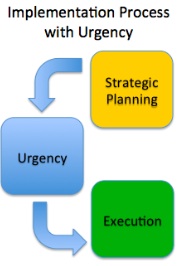
The Missing Element in Your Organizational Strategy
In a cover story for a recent issue of Harvard Business Review, Professor John Kotter described a new type of organization that combines speed of execution with agility to seize new opportunities quickly. “Speed plus agility” is the holy grail that leaders of organizations seek to achieve. Many don’t. There are two big missing pieces that are overlooked by a majority of leaders. This blog describes one of them.
Recently, I was presenting to a group of senior executives from 40 different companies. They represented many different industries and were from different parts of the world. I asked them to work collectively to design the perfect, high-speed, fast-executing organization. What would it look like? What would it feel like? What processes would it have in place? I kept gathering ideas until they had exhausted all of their thoughts and insights.
What they came up with was an organization with a clear strategy, where everyone is urgent and aligned toward a common goal, and where execution of those strategies flowed smoothly with all of the management processes you would expect in place. They had designed the typical process most people think successful companies use to implement new strategies.
“So what is missing,” I asked? “Nothing,” they responded. “Let me ask you all a question,” I continued, “Tell me how well this model works at seizing new opportunities or going after new strategies that require a lot of change?” They scratched their heads as they thought about this, but they came up with an answer that is confirmed by research, that only about 30 percent of organizations are good at seizing new, strategic opportunities. Put another way, 70 percent fail trying to do so. So I asked again, “What is missing?” Silence.
One answer that we have uncovered in our work — and it’s something John Kotter learned a long time ago — is that a missing piece required for speed and agility is an “urgency process.” When I say an “urgency process,” I mean including an actual process — as essential as your strategic planning and execution processes — that is dedicated to creating urgency.
When I mention an “urgency process” to groups of executives, I’ll often hear things like, “What is an urgency process?” and “We did not learn this in business school.” Well, here’s one way of defining it: An urgency process is a quantifiable and repeatable way to generate alignment, urgency, and engagement in a majority of employees in a company, division, functional area, or large team. Some of the elements it contains are:
- Senior leadership team alignment around a market opportunity
- An urgency team
- Urgency initiatives to create alignment, urgency, and engagement
- A way to capture names of urgent employees that want to volunteer to help
- A means of measuring urgency to ensure at least 50 percent of the organization is urgent
To be clear, an urgency process is not a communications plan. A communications plan is typically a one-way set of activities designed to inform and create awareness. It is not typically designed to align and engage employees as volunteers to take action.
So what do you do when you have 50 percent of your employees in your team, division, or organization urgent and raising their hand to help? How do you put them productively to use?
Read more from Kotter International here.

Tags: Alignment, John Kotter, Randy Ottinger, Strategy, Vision Clarity



















